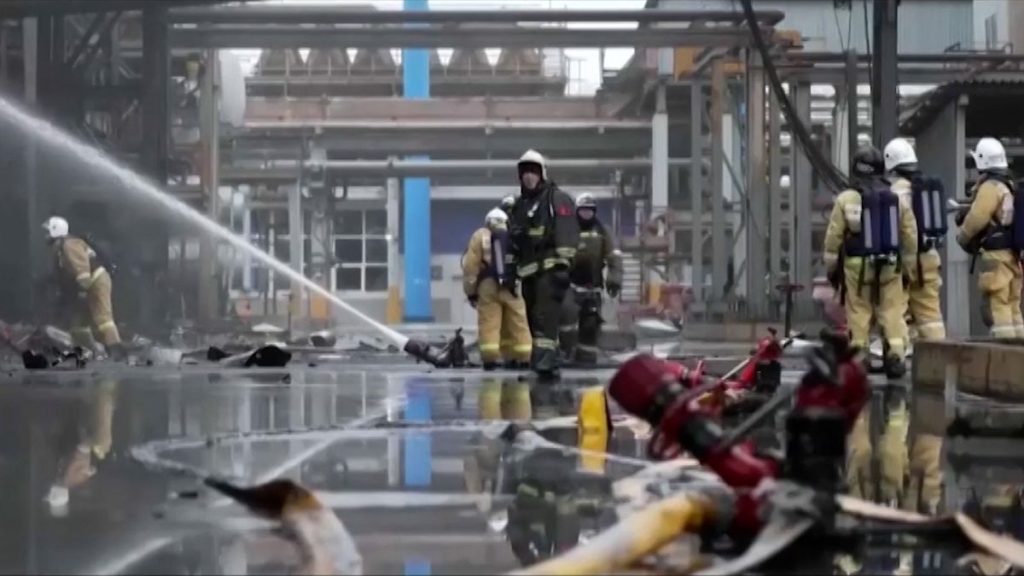The overnight hours witnessed a surge in drone activity across several Russian regions, with Russia claiming its air defense systems neutralized 70 Ukrainian drones. The targeted areas included Belgorod, Kursk, and Voronezh, regions bordering Ukraine and frequently subjected to cross-border attacks. This incident underscores the escalating use of drone warfare in the ongoing conflict, with both sides increasingly relying on unmanned aerial vehicles for reconnaissance, targeting, and disruption. The scale of the reported interception, however, raises questions about the accuracy of the claim and the potential for exaggeration in the context of the information war surrounding the conflict. While Russia asserts successful defense against these drones, the frequency and depth of penetration into Russian territory suggest ongoing vulnerabilities in its air defense network.
Among the reported targets was a major gas processing plant located in Astrakhan, a strategically significant facility responsible for a substantial portion of Russia’s gasoline, diesel fuel, and sulfur production, the latter being a crucial component in explosives manufacturing. Ukrainian authorities claimed responsibility for the attack, asserting it as a successful strike against a key element of Russia’s industrial infrastructure. While the Astrakhan governor confirmed the drone attack and the temporary shutdown of operations, he downplayed the incident, attributing the halt to routine procedures and emphasizing the safety of personnel. Footage from the site revealed a fire, which authorities claimed was swiftly extinguished. The governor’s statements and the released footage suggest an effort to minimize the perceived impact of the attack and project an image of control and resilience.
The Astrakhan gas processing plant attack is particularly noteworthy due to the facility’s importance to Russia’s energy sector and military capabilities. Processing over 8,000 tons of gas condensate daily, the plant plays a vital role in supplying fuel for both civilian and military applications. The disruption, even if temporary, could potentially impact Russia’s fuel supply chain and, more significantly, its production of explosives, highlighting the vulnerability of critical infrastructure to drone attacks. The incident underscores Ukraine’s increasing ability to project force deep inside Russian territory and target strategically important assets.
In addition to the Astrakhan gas plant, another prominent target was the Lukoil oil refinery in Volgograd, marking the second attack on this facility within three days. This refinery, responsible for processing a significant portion of Russia’s oil, represents a high-value target for Ukraine, aiming to disrupt Russia’s energy sector and economic stability. The repeated attacks on this particular refinery suggest a deliberate strategy by Ukraine to inflict sustained damage and hinder Russia’s oil production capacity. The Russian authorities confirmed a brief fire at the facility but, similar to the Astrakhan incident, likely downplayed the extent of the damage to avoid projecting vulnerability.
These attacks represent a broader trend of Ukraine’s increasing reliance on drone warfare to counter Russia’s military advantages. As the war approaches its third year, Ukraine has demonstrated a growing capability to strike targets deep within Russian territory, disrupting critical infrastructure and putting pressure on the Russian military. This tactic allows Ukraine to project power beyond its borders and challenge Russia’s perceived dominance, particularly in the face of Russia’s superior air power. The drone attacks also serve a psychological purpose, demonstrating Ukraine’s resilience and determination to resist the invasion.
The escalating drone warfare presents several significant implications for the ongoing conflict. It highlights the growing importance of unmanned aerial vehicles in modern warfare, their ability to bypass traditional defenses, and their potential to disrupt critical infrastructure. The increasing frequency and range of Ukrainian drone strikes into Russian territory pose a challenge to Russia’s air defense capabilities and create a sense of vulnerability within its borders. These attacks also contribute to the escalating tensions between the two countries and further complicate efforts towards a peaceful resolution. The use of drones, while potentially effective tactically, also raises concerns about the potential for escalation and the blurring lines between conventional and asymmetric warfare.














